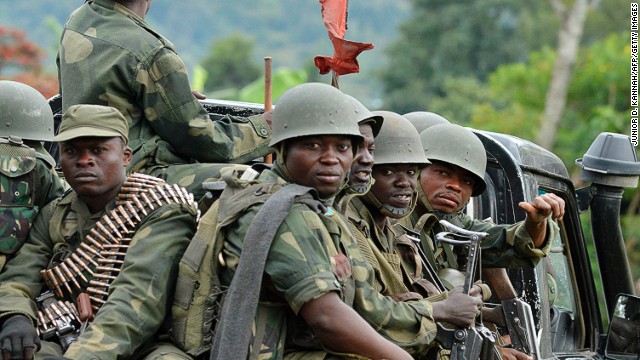
Military successes in the Democratic Republic of Congo have led the M23 militia group to announce its intention to disarm.
Pictured, army soldiers head towards the Mbuzi hilltop, near Rutshuru, on November 4, 2013, after the army recaptured the area from M23.
STORY HIGHLIGHTS
- DR Congo’s M23 militia has announced it will disarm
- Situation in Congo remains uncertain, says Vava Tampa
- Conflict is driven by groups wanting access to Congo’s valuable minerals
- Numerous U.N.-backed peace deals have so far failed to bring peace
Recent military gains against the M23 militia in the east of the Democratic Republic of Congo are an encouraging development, a respite from the impasses faced by Congo.
But behind the headlines that M23 has announced it will disarm, all still is far from well. No one can say with any degree of certainty how this situation will play out or what will happen when the Tanzanian, South African and Malawian military forces that have formed the backbone of the recent military surge leave eastern Congo.
Here are eight reasons why we should keep focused on Congo.
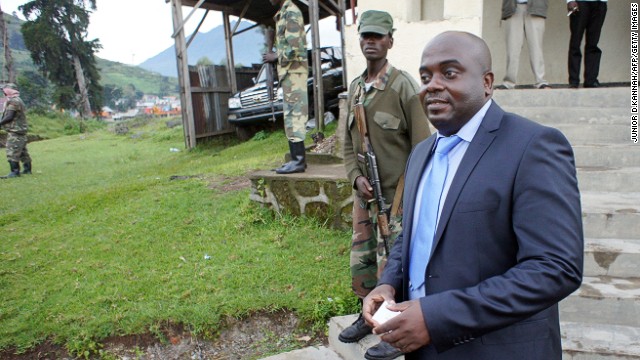
In a statement on M23's Facebook page, leader Bertrand Bisimwa, pictured on April 26, 2013, said the group would immediately end its rebellion and "pursue, by purely political means, a search for solutions to the profound issues that led to its creation."
The world’s most horrific atrocity since World War II
The full extent of Congo’s decade-long orgy of unimaginable slaughter remains unknown. However, we know that by 2008, 10 years after the 1998 Rwandan-led invasion of Congo, more than 5.4 million people had been killed, a figure that rises every month because of conflict, disease and famine. And the social and human cost in terms of mass displacement and the use of children as combatants is incalculable.
The largest U.N peacekeeping mission in the world
Congo, Africa’s largest sub-Saharan country, is typically described as home to the largest U.N. peacekeeping mission in the world. However, what is often left unexplained is the sheer size of Congo’s perilous insecurity situation. Even with the entire 20,000 U.N. peacekeepers deployed to three of Congo’s most volatile provinces (North Kivu, South Kivu and Ituri) their task amounts to patrolling an area the size of Demark, the Netherlands, Switzerland, Belgium, Luxembourg, Cyprus, Gibraltar, Malta and Andora combined — with numerous hostile and disgruntled rebel groups.
Some are fighting each other; some are from neighboring countries fighting their governments from Congo, others are fighting President Kabila’s regime — which they see as a corrupt and incompetent — while yet others have been accused of fighting Congo on behalf of neighboring governments.
Conflict minerals
Though grievances might have been the spark that triggered the fighting, the struggle for control of Congo’s minerals is driving the conflict.
Congo has abundant diamond, gold, coltan, copper, cobalt and timber and politicians in Congo, Uganda and Rwanda have been accused of — and denied — training and arming rival militia for access to these riches, and then leaving them to destroy one another, and the local population.
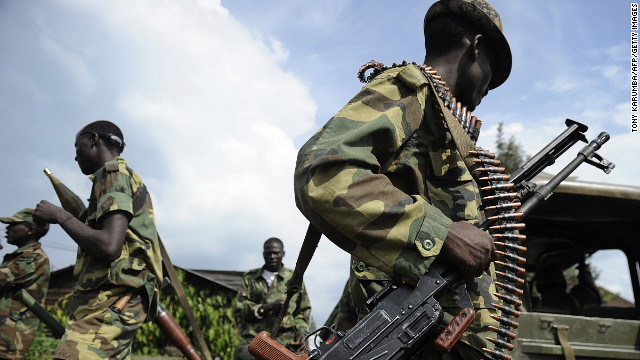
The M23 group launched an offensive in DR Congo in November 2012. Pictured, M23 soldiers stand guard at the former Congolese army headquarters in Goma, on November 23, 2012, after it was abandoned by fleeing Congolese army soldiers.
Peace deals
There have been numerous U.N.-backed peace deals in Congo since 1998. But by nearly all estimates the peace deals have offered no real promising solution to ending the Congo wars. Threats of continued fighting and greater humanitarian crises still loom almost unhindered. Warlords and their guns are still in charge and reports of abuse, rape and the use of children as combatants remain as widespread as they were when the Lusaka Ceasefire Agreement was signed in 1999.
Crisis of legitimacy
Among Congo’s biggest problems is its crisis of legitimacy — some say leadership. Indeed, if President Kabila’s regime — 10 years after the EU sent a military intervention to the country — were going to address social ills that gives rise to conflict and disputes, heal sectarian wounds, reform its security sector, end impunity, improve national institutions or tame relations with Rwanda — it would have done so by now. Pretending otherwise is delusional and until this crisis is resolved not will change.
Rwanda’s role in Congo
There is a lot of blame to go around for the killing, raping and displacement of the Congo’s innocent population, but according to the United Nations, Rwanda helped to create and support the M23 militia — a charge repeatedly denied by Rwandan President Paul Kagame.
And though M23 is now all but finished, the continued presence of the FDLR in Congo’s eastern region must be addressed if peace is to resume in Congo.
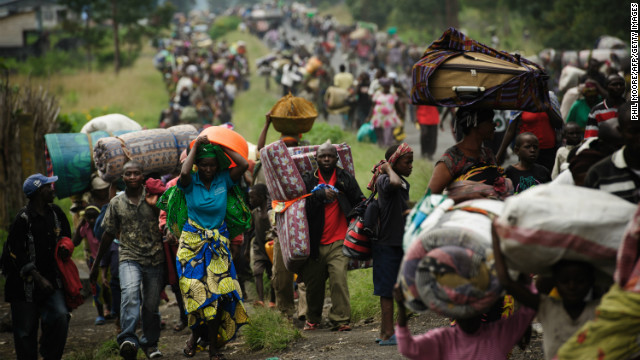
The violence drove tens of thousands of Congolese from their homes. Here on November 22 2012, thousands fled the town of Sake and headed east to the camps for displaced in the village of Mugunga.
What to do with the FDLR?
The wars consuming the Congo have many layers, and one of the thorniest is what to do with the FDLR, the Hutu refugee rebel group accused of a litany of massacres and mass rape in Congo, and whose leadership took part in the Tutsi genocide in 1994.
There is a new debate in the region, spearheaded by Tanzania’s president, on finding a settlement on this long-sidelined issue. But Rwanda remains fragile and mistrust between the Hutus and the Tutsi remains, sadly, high, and Kigali continues to see the return of Hutu refugees — many of whom witnessed the slaughter of their parents and families in refugee camps in Congo– as a threat to its existence.
The “rape capital of the world”

DR Congo is home to 20,000 U.N. peacekeepers, but they are tasked with covering a vast area on the eastern part of the country.
Congo’s wars have left more shock wounds on women’s body than on the streets and buildings of that country. Rape has become the most used, effective, yet cheapest weapon in that war, used to displace, punish, humiliate and destroy families and communities on an industrial scale.
It’s a slow form of psychological murder, deliberately tearing the social fabric of an already bruised and battered society. And in the age of HIVAIDS this tactic promises to kill even more Congolese people long after the wars in that country end.

Congo's conflict is driven by groups trying to control its natural resources. The country has abundant diamond, gold, coltan, copper and cobalt reserves.
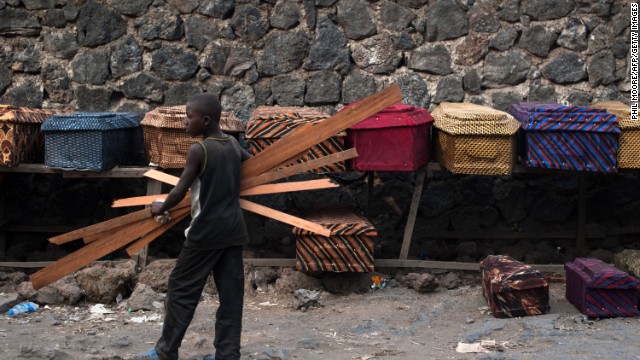
Coffins for sale in the east of Congo in August 2013. By 2008 more than 5.4 million people had been killed in Congo as a result of ongoing conflict.

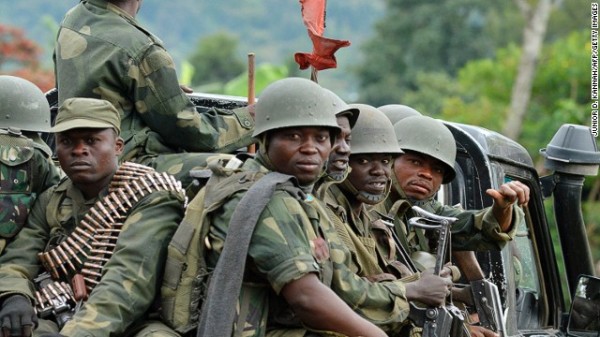

Leave a reply